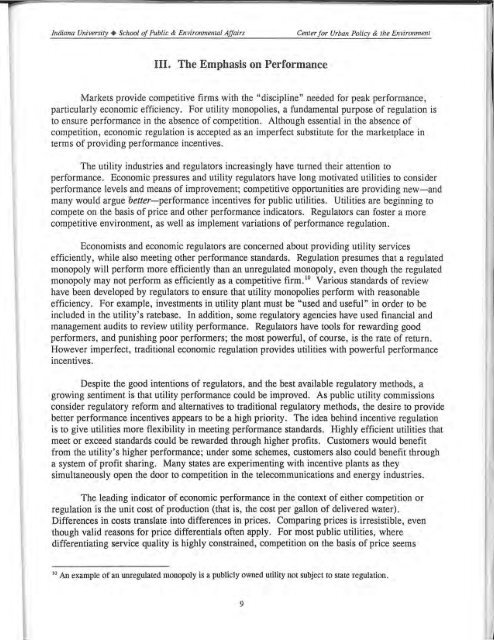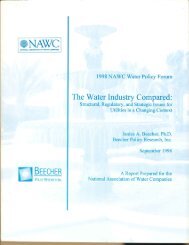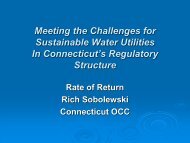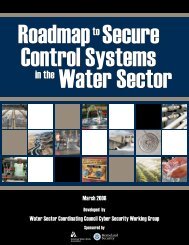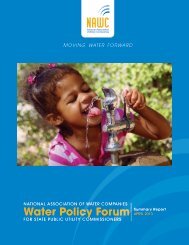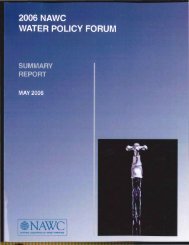CENTER FOR URBAN POLICY AND THE ENVIRONMENT - NAWC
CENTER FOR URBAN POLICY AND THE ENVIRONMENT - NAWC
CENTER FOR URBAN POLICY AND THE ENVIRONMENT - NAWC
Create successful ePaper yourself
Turn your PDF publications into a flip-book with our unique Google optimized e-Paper software.
Indiana University + School of Public & Environmental AffairsCenter for Urban Policy & the EnvironmentIII. The Emphasis on PerformanceMarkets provide competitive firms with the "discipline" needed for peak performance,particularly economic efficiency. For utility monopolies, a fundamental purpose of regulation isto ensure performance in the absence of competition. Although essential in the absence ofcompetition, economic regulation is accepted as an imperfect substitute for the marketplace interms of providing performance incentives.The utility industries and regulators increasingly have turned their attention toperformance. Economic pressures and utility regulators have long motivated utilities to considerperformance levels and means of improvement; competitive opportunities are providing new-andmany would argue better-performance incentives for public utilities. Utilities are beginning tocompete on the basis of price and other performance indicators. Regulators can foster a morecompetitive environment, as well as implement variations of performance regulation.Economists and economic regulators are concerned about providing utility servicesefficiently, while also meeting other performance standards. Regulation presumes that a regulatedmonopoly will perform more efficiently than an unregulated monopoly, even though the regulatedmonopoly may not perform as efficiently as a competitive firm. 10 Various standards of reviewhave been developed by regulators to ensure that utility monopolies perform with reasonableefficiency. For example, investments in utility plant must be "used and useful" in order to beincluded in the utility's ratebase. In addition, some regulatory agencies have used financial andmanagement audits to review utility performance. Regulators have tools for rewarding goodperformers, and punishing poor performers; the most powerful, of course, is the rate of return.However imperfect, traditional economic regulation provides utilities with powerful performanceincentives.Despite the good intentions of regulators, and the best available regulatory methods, agrowing sentiment is that utility performance could be improved. As public utility commissionsconsider regulatory reform and alternatives to traditional regulatory methods, the desire to providebetter performance incentives appears to be a high priority. The idea behind incentive regulationis to give utilities more flexibility in meeting performance standards. Highly efficient utilities thatmeet or exceed standards could be rewarded through higher profits. Customers would benefitfrom the utility's higher performance; under some schemes, customers also could benefit througha system of profit sharing. Many states are experimenting with incentive plants as theysimultaneously open the door to competition in the telecommunications and energy industries.The leading indicator of economic performance in the context of either competition orregulation is the unit cost of production (that is, the cost per gallon of delivered water).Differences in costs translate into differences in prices. Comparing prices is irresistible·, eventhough valid reasons for price differentials often apply. For most public utilities, wheredifferentiating service quality is highly constrained, competition on the basis of price seems10An example of an unregulated monopoly is a publicly owned utility not subject to state regulation.9


